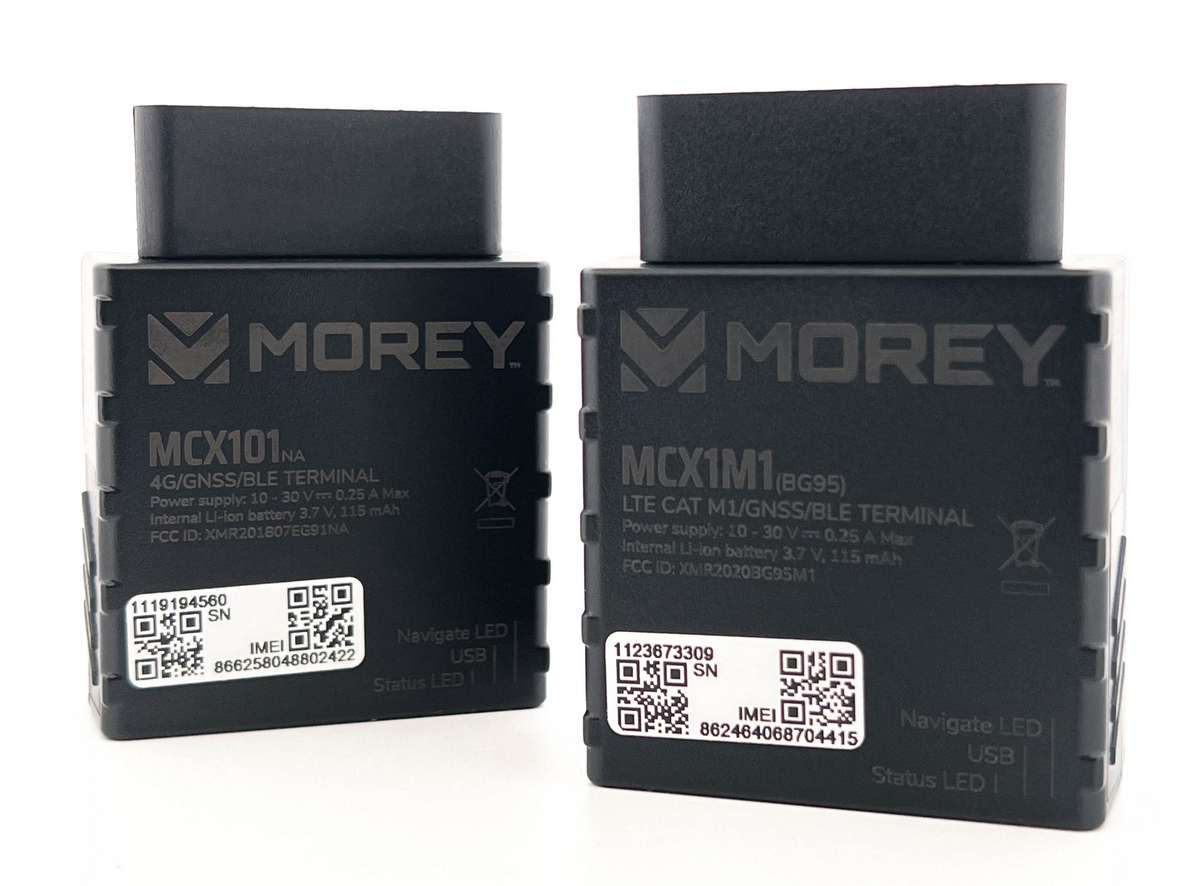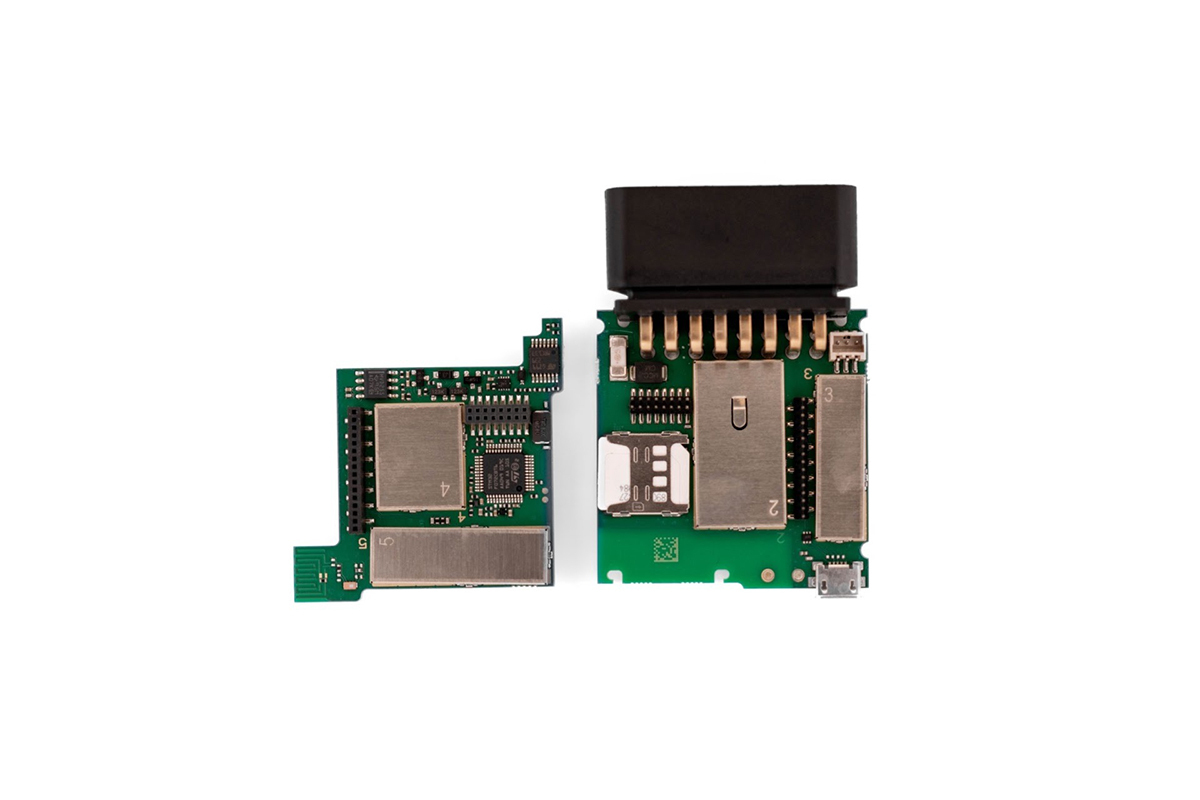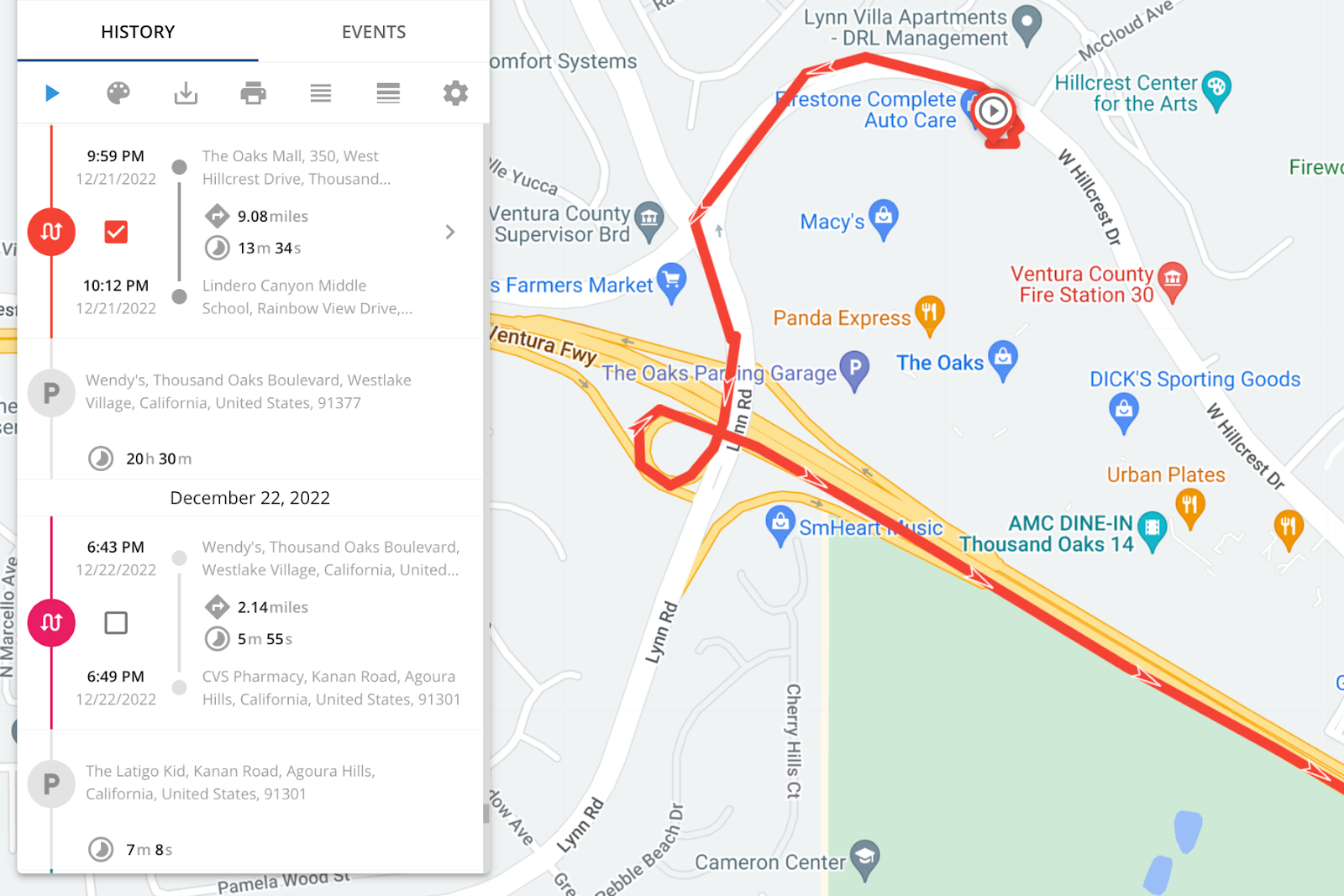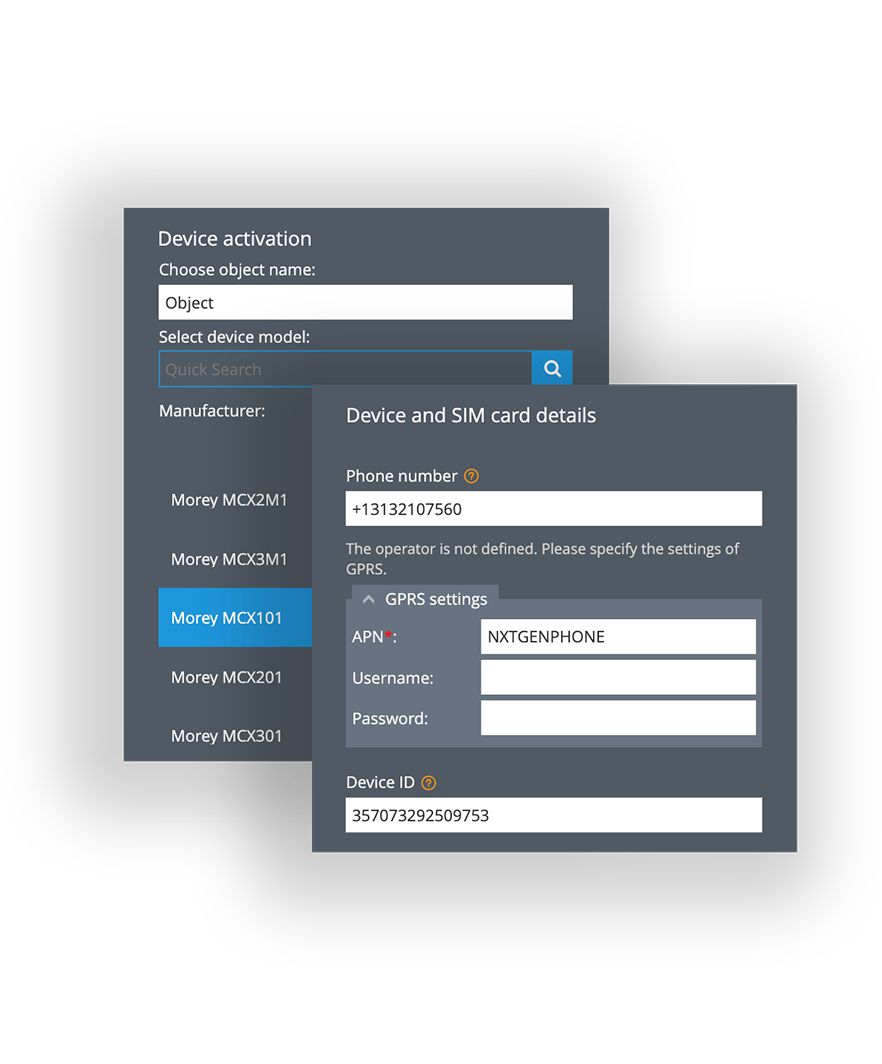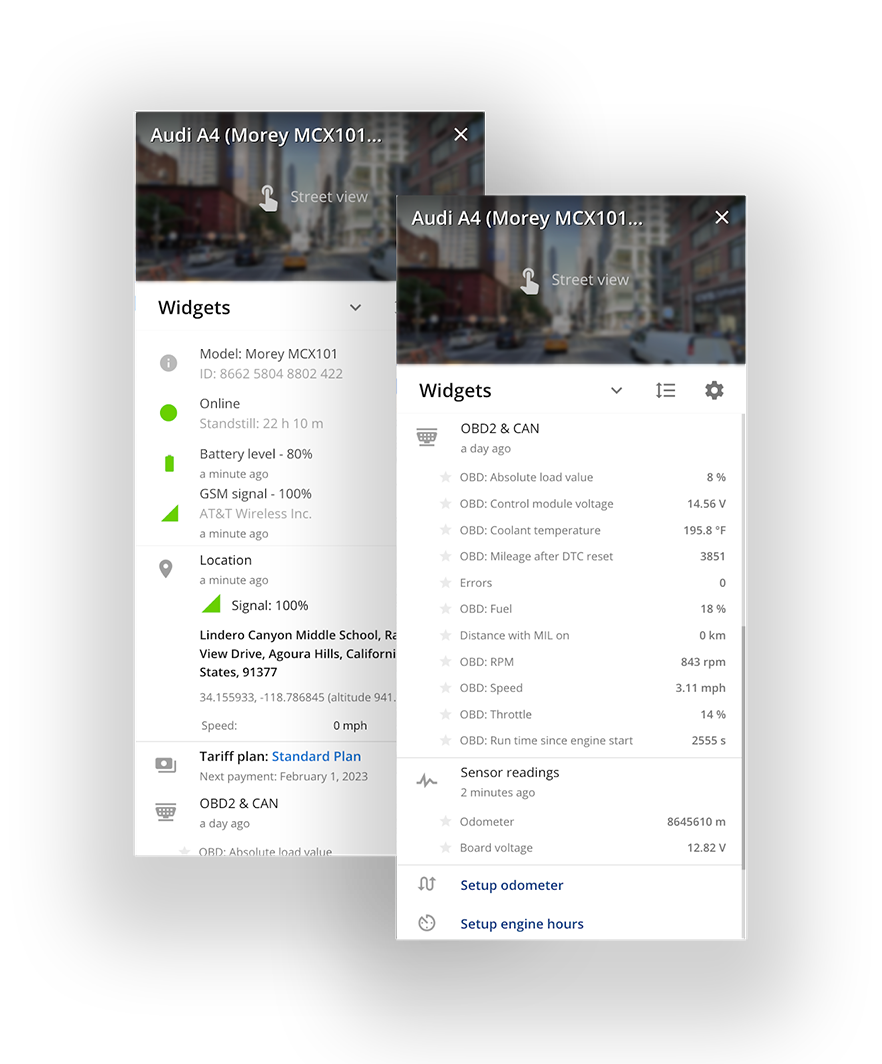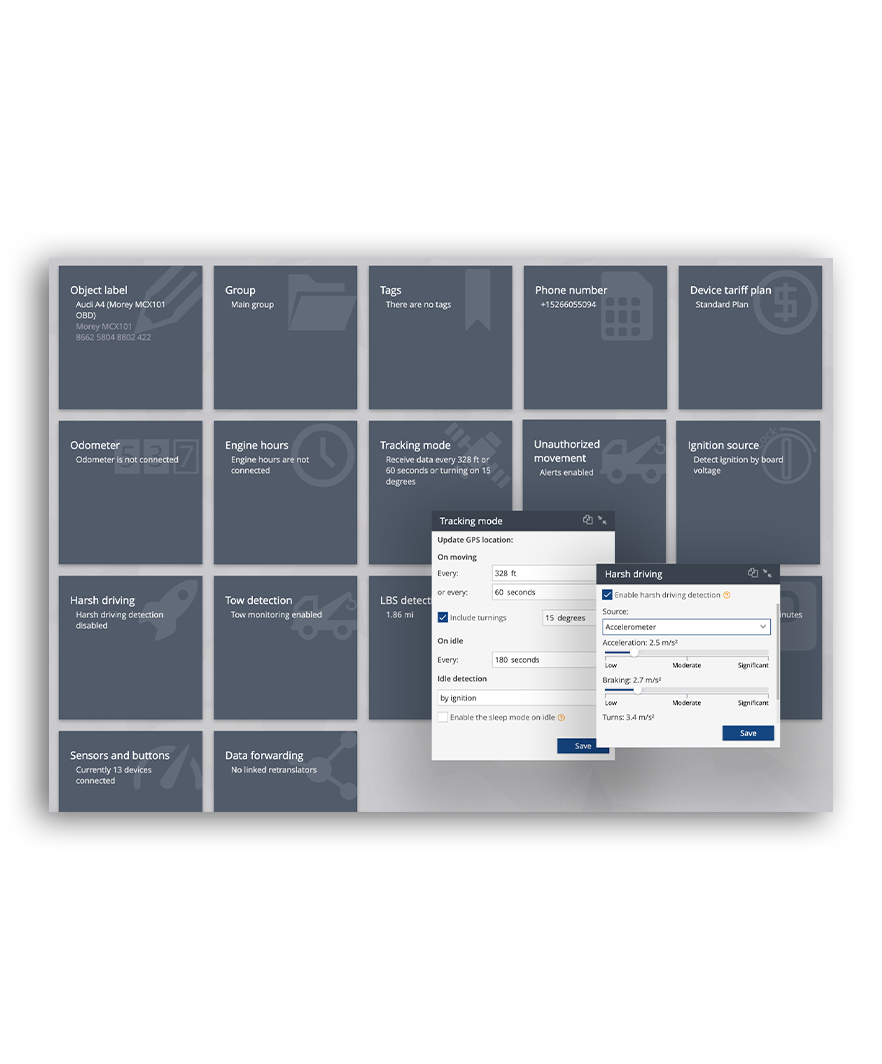Navixy’s Advantage League verdict
The Morey MCX series is an easy-to-install OBDII tracker for cars and light commercial vehicles available in two variants — the MCX1M1 / MCX101. It is certified in the US and equipped with an LTE-M / LTE module to work in the US, Canada, Mexico, and other countries with 4G coverage. Thanks to its affordability, flexible settings, and ample capability of reading OBDII parameters from conventional and electric vehicles, the MCX series is one of the best OBD trackers for vehicles in North America.
The Morey MCX1M1 and MCX101 are exactly the same with the exception of their supported cellular networks (Cat M1 vs Cat 1), so any description regarding their functionalities can be assumed to be accurate for either device.
Pros
- Accurate and flexible tracking A-GPS / LBS
- Long list of configurable events
- Full OBDII data PIDs with OEM parameters
- Bluetooth connectivity for sensors
Cons
- No J1939 data for heavy duty vehicles
- No buzzer for direct sound feedback to driver
- No anti-tampering / sabotage
- SMS command syntax has compatibility issues and may fail to properly execute during remote configuration
OBD Trackers on the Rise
OBD trackers are rapidly gaining worldwide popularity thanks to their convenient design, intelligent features, and cost-effective implementation. Fleet managers not only use these tools to pinpoint vehicle’ location, but also to better understand performance through CAN bus parameters – something not all traditional GPS trackers can provide.
In a rapidly growing market niche, manufacturers are racing to develop OBD devices that are loaded with the latest technology yet still competitively priced. But with so many sophisticated features to consider, choosing the right device can be quite difficult, so we have you covered with a series of unbiased reviews on OBD trackers. In this review, we’ll examine two OBD trackers designed by Morey Corporation for the US market: the MCX1M1 and MCX101, or the MCX series.
Designed for the US Market
GPS trackers in the US need to meet various legal and other requirements to be suitable for the American market, such as government approval by the FCC and connectivity testing performed by PTCRB and other cellular operators. We’ll explain why these topics are so important to understand below.
LTE and LTE-M connectivity
In North America, different cellular networks are available for IoT solutions, including Cat 1 and Cat M1. So, to ensure you can use the MCX on either option, Morey has two variations to consider: MCX1M1 and the MCX101.
The primary difference between MCX1M1 and the MCX101 is that the former was created for Cat M1 network coverage in North America, while the latter supports more globally available Cat 1 connectivity. Since Cat M1 is a newer network and many countries are still upgrading their infrastructure, it may not be available everywhere.
| Morey MCX1M1 | Morey MCX101 |
|---|---|
Recommended use:
| Recommended use:
|
Cat M1 networks are designed to facilitate the modern applications of IoT, using a reduced bandwidth that calls for less complex hardware designs and therefore lower device prices.
If your vehicles only operate in the US and Canada, then you can choose the MCX1M1 for Cat M1 access to enjoy lower costs without compromising quality or network reliability.
On the other hand, fleets that expect to operate in countries like Mexico, where LTE Cat M1 networks are still in development, should opt for the MCX101 which is designed for LTE Cat 1 networks.
Certification: FCC, RoHS, PTCRB, and more
In the United States, GPS trackers are subject to an array of stringent regulations, including gaining certification from the FCC, PTCRB, and, in certain states, RoHS, in order to be used, sold, and marketed.
| Mandatory certifications in the US | |
|---|---|
| FCC | The Federal Communication Commission (FCC) must certify any communication device that is sold, produced, or marketed in the United States. |
| Mobile Network Operators |
|
| RoHS | Only fully enforced in California, but other states (New Jersey, Illinois, Indiana, Minnesota, New York, Rhode Island, and Wisconsin) have laws based on RoHS standards. |
Both Morey devices have undergone mandatory certifications including FCC and RoHS to guarantee RF and safety compliance. Additionally, they are PTCRB certified and included on the Verizon Open Development list, so they can be used with leading carriers such as AT&T, T-Mobile, Verizon, and US Cellular.
Although the Morey devices are only intended for sale within the United States and don’t have specific certifications for other countries, their users can still travel to Mexico, Canada, and practically any region without any worries as long as the cellular service provider allows roaming.
Design and Enclosure
The MCX series is highly functional but still compact in size, offering a more convenient design than many of its competitors. Opposite the OBD port, two small LED lights indicate device status, so they won’t interfere with nighttime driving. Additionally, the casing doesn’t require a screwdriver to open – any slim plastic tool will work. Not to mention, the device carries an industry-standard IP41 rating.
The housing is only required to be opened once for inserting the micro-SIM and making sure that the Li-ion backup battery is securely connected to the board – it will provide around three hours of service in active mode.
Location Positioning
The MCX1M1/MCX101 is primarily devoted to location positioning, and this can be accomplished with a combination of GNSS signal reception, LBS / Cell ID functionality, and motion detection abilities. To better understand how each of these features are used in different scenarios, we will explain them in more detail below.
GNSS capabilities
The Morey MCX series is based on the Quectel module, which supports GPS, GLONASS, BeiDou, and Galileo. In addition to good tracking sensitivity (-165 dBM for tracking), the device also supports Assisted GPS functionality to improve time to the first fix (TTFF).
Supporting A-GNSS features should be accessible in your VPN/MVNO networks. With Morey devices that are based on the Quectel module, it’s necessary to maintain access to the EPO (Extended Prediction Orbit) files.
If you use the SIM cards from Navixy’s recommended MVNOs (or supplied directly by Navixy), no action is needed. Otherwise, please consider contacting the Navixy support team for proper private network configuration and network environment testing.
GPS tracking modes
To provide high tracking accuracy when driving and low power consumption when idling, Morey has multiple independently configurable tracking modes. This flexibility also helps reduce data consumption and related costs when a vehicle leaves the country and enters a roaming area.
| Conditions | Description |
|---|---|
| Driving mode | Driving mode is activated when two conditions are met simultaneously: ignition is detected (read about ignition detection below) and 4 or more GPS satellites are locked. The location is updated and continuously reported to the GPS tracking server based on the following parameters and conditions:
All of these conditions may be applied simultaneously or separately; if the value is set to 0, the parameter is not considered. |
| Parking mode | Parking mode is activated immediately after the ignition is turned off (read about ignition detection below). In this mode, the location is updated in equal time intervals only. The default value is 120 seconds. |
| Sleep mode | Sleep mode saves vehicle battery power when it goes unused for an extended period of time. This mode is helpful to avoid situations like battery drainage, which prevents the vehicle from starting. After activating Sleep mode, device power consumption decreases from an average of 30-35 mAh to 4-15 mAh, depending on the chosen sleep depth as described below.The timeout interval that activates this mode can be set in minutes from 1 to 3000 and starts counting once the device goes to “While parking” mode as described above. The device goes into sleep mode if two conditions are met within the set timeout interval:
The device turns off sleep mode automatically if either of the following conditions is met:
There are four depth levels of the sleep mode:
For the majority of real-life situations, GPS sleep and Online Deep Sleep modes are sufficient. By default, Sleep mode is disabled. |
| Roaming | If a device is expected to operate in the roaming network (e.g. during cross-border trips), separate tracking settings can be configured for “While driving” and “While parking” modes. These alternative configurations are activated automatically when the vehicle flips between home and roaming networks. For example, in the “On Roaming” mode, you can decrease the frequency of location updates to reduce data consumption and costs in roaming. |
All sleep modes and parameters can be configured remotely using SMS or IP commands, as well as locally with a USB cable and Windows-based configurator.
Determining driving and parking statuses
Driving and idling statuses are both closely related to the ignition status, which in turn is detected based on information from the four sources listed below, going from most to least exact.
| Source | Description |
|---|---|
| PIN 1 | If there is power on the ignition pin (number 1) of the OBDII connector |
| Board voltage | When the engine is on, the board voltage increases (which also allows the battery to be charged by the alternator). This change in voltage is used for ignition detection. By default, this is 13 volts, which is the recommended value for vehicles with 12-volt board voltage and can be fine-tuned if necessary. For trucks, tractors, and other heavy-duty vehicles with 24-volt board voltage, the threshold needs to be configured to 25 volts. Please note that this source is not suitable for hybrid and electric vehicles. |
| Motion sensor | This option enables vehicle movement status by the built-in accelerometer. To prevent false triggering (e.g. a strong gust of wind from a passing vehicle), there is a delay threshold parameter for continuous movement. It can be set from 1 to 60 seconds, with a default value of 2 seconds. |
| Position change | Vehicle movement status is detected by GNSS coordinate change. When coordinates change, concurrent GNSS sources may be used:
|
Starting with firmware version 03.25.14, it is possible to use a combination of multiple (from one to four) sources simultaneously to detect vehicle movement and/or idling status.
Odometer: CAN and GPS
Mileage on the Morey MCX1M1 can be read via two methods:
- CAN bus data
This is the exact same value that is displayed on the vehicle’s dashboard. This is an ideal source of mileage information but can’t be read from every vehicle, so Morey provides a full list of makes and models that are supported with the current HW and SW versions. - GPS-based mileage
An alternative way of acquiring mileage information is with the internal counter of miles driven. The counter is updated at a very frequent rate (independently from the parameters set for the tracking modes), which brings fairly accurate measurements. However, the mileage in this case will be different from the mileage stated on the vehicle’s dashboard. In practice, the difference between the readings from GPS and the vehicle odometer may be within 5 to 15%.
In Navixy, both data sources can be used for mileage calculations. Their actual values are displayed in the corresponding widgets and are used in analytical reports (including fuel consumption) and predictions.
For GPS-based mileage, the counter displayed on the web or mobile interface may be adjusted for convenience. Also, the value can be automatically adjusted by an empirical coefficient for better accuracy.
Cell ID positioning
Even though the Morey MCX1M1 and MCX101 have high GPS sensitivity, they also offer Cell ID positioning (also referred to as LBS or Location-Based Services positioning) as a backup to GNSS when the signal is blocked, such as:
- In subterranean, multi-level parking areas where there is no GPS signal reception
- In covered areas with unstable satellite coverage
- As protection against car theft with the use of jamming devices
As a type of supplemental technology, Cell ID positioning is less accurate than satellite navigation. In practice, the accuracy of an estimated position mostly ranges from 300 to 1000 yards in urban areas and 2 and 5 miles in rural areas. The Morey MCX constantly searches for satellite signals when LBS is in use and, once restored, switches back to satellite positioning.
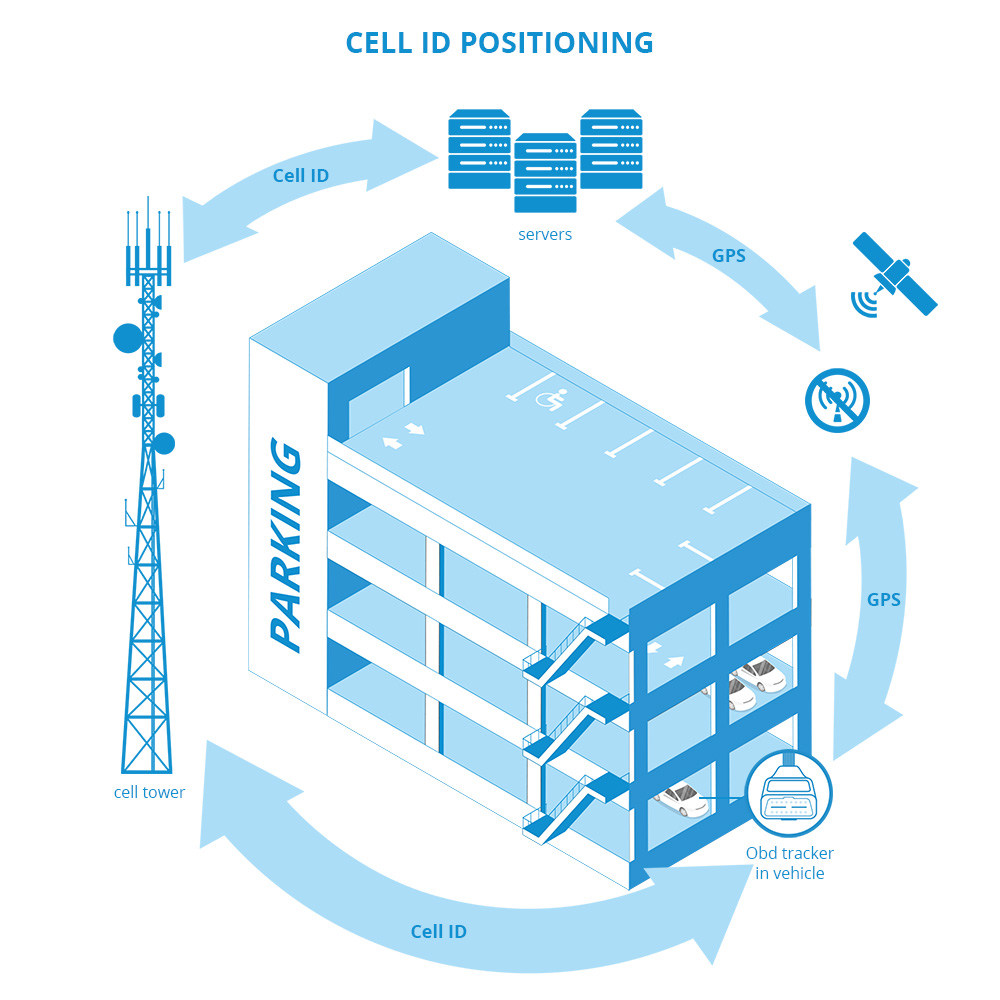
LBS positioning is available with the Morey MCX1M1 and it is not configurable. Navixy fully supports LBS technology in 240 countries by transforming the CID data received from the devices to its approximate position. This feature may be configured by setting the minimum required accuracy (so less accurate positions will not be considered as valid) or completely disabled.
Data consumption
The amount of data consumed by your device depends on the tracking modes and IP protocol you select. Fortunately, whether accuracy or cost-effectiveness is most important, the Morey MCX series can be tailored to maximize either need. It also lets you communicate with servers over both UDP and TCP protocols, since choosing UDP will ensure minimal data utilization.
In practical scenarios, data consumption is generally estimated to range from 1.5 and 5 MB per mile of travel, with an average of 2.5 MB per mile.
Depending on your IoT requirements, you may need to thoroughly consider the different tracking mode parameters to find the right balance between track quality and data costs. Below, we provide our recommended configurations for the Morey MCX device for the most common scenarios:
| Track quality preferred | Cost saving preferred | |||||||||||||||||
|---|---|---|---|---|---|---|---|---|---|---|---|---|---|---|---|---|---|---|
| While driving |
|
| ||||||||||||||||
| While parking |
|
| ||||||||||||||||
| Sleep mode | Online deep sleep | Online deep sleep |
Real-world testing
We tested Morey MCX101 in urban, mountain, and wooded environments to see if connectivity was affected. Across the board, we had no issues with tracking, both when driving and in parking lots. After the car was parked underground for a few days, the tracker only needed anywhere from a few seconds to a minute to reacquire its position. Unless the device is installed in a concealed place, such as under the dashboard, you shouldn’t have any trouble with tracking accuracy in regular cars.
Navixy allows telematics professionals to flexibly configure initial settings and remotely execute specific OTA (over-the-air) commands over SMS and IP. Among other unique features, the platform offers fully automatic device activation and an intuitive graphical interface that allows users to control their devices, including tracking modes.
- Automatic device activation when uploading the initial settings profile
Connecting a single device (bulk devices) to Navixy does not require prior manual configuration. The system uses a number of SMS / IP commands to activate the device based on minimal information about the device: its IMEI number and the SIM card (ICCID or associated phone number). The configuration profile, including APN settings and preferred device settings, uploads fully automatically, and the device is fully operational in a few seconds. This approach significantly reduces labor, speeds up the installation, and eliminates configuration errors. - UDP and TCP supported
Both transport-layer protocols are supported by Navixy, which means you can choose either one. For lower data costs we recommend using UDP. - Air console for OTA device configuration
The support tools provided as part of the administration panel allow technical specialists to send customized commands to devices via SMS and IP channels. The responses from the devices are parsed and presented in an easy-to-use format. - User interfaces for device settings change
End users may see and update common device settings remotely via the easy-to-use graphic interfaces of our web and mobile apps. These settings include the most common parameters, such as device tracking modes, parking detection, Cell ID location preferences, and more. This functionality may be limited to specific user roles only or switched off completely if a TSP decides to do so.
Events with Flexible Configuration
The Morey MCX has advanced onboard logic that sets it above the competition and significantly expands the device’s range of applications. Its sophisticated algorithms utilize data taken from GPS and cellular modules, accelerometer, power voltage, and OBDII stream, making the MCX an invaluable tool for monitoring driving conditions, improving vehicle performance, enhancing security, and more.
Featured events
First, let’s review some of the most noticeable features that many of Morey’s competitors lack or are simply inferior to in terms of logic.
Ignition start/stop
In the Morey OBD device, the ignition state is determined by either board voltage, engine RPM, or movement detected by the accelerometer. This helps to correctly determine the ignition state of conventional and electric cars, LCVs, and other light vehicles.
- Board voltage: Since the device is powered from the OBDII port, it can directly measure board voltage. If the voltage level is higher than the adjustable threshold set for 12V or 24V vehicles, the ignition is considered to be in the ON state; otherwise, it is in the OFF state. Note: this method is not suitable for electric vehicles.
- Engine RPM: This method is only applicable for conventional vehicles and only if the engine RPM value is accessible in the OBDII data stream. Any RPM value above zero switches the ignition state to ON.
- Accelerometer: When the built-in G-sensor detects movement, the ignition goes to ON. Otherwise, it is OFF.
When two or more sources are selected, at least one condition must be met to change the ignition state.
Towing
The towing alert triggers when a parked vehicle (with the engine switched off) starts moving, which is detected by the built-in accelerometer.
Specifically, the alert is sent when the ignition is off but the acceleration or tilt angle reaches the set threshold value. The feature can be configured through the thresholds for the tilt angle (0.5-30°), acceleration (0.1-10 g), impact duration, and time to activate and deactivate after the ignition state change. This flexibility covers a wide range of applications and helps to avoid false triggering, such as when the driver and passengers are getting into the vehicle.
Tracker removal
This event is generated when the device is unplugged from the OBDII port. It has two modes:
- Standard: based on external power only and recommended for most vehicles where the OBDII port continues to supply power after the vehicle’s ignition is switched off.
- Advanced: defined by the combination of external power and accelerometer. It is suitable for some vehicles where power is not supplied via the OBDII port after the ignition is switched off.
Geofence
Geofence-related events are particularly useful since they let you know whenever a vehicle enters or exits a specific zone. Moreover, the Morey MCX has a unique feature called “Auto Geofence” that assists with preventing vehicle theft to give you extra peace of mind.
| Geofence type | Description |
|---|---|
| Manual geofence | Device allows setting up to 50 rectangular or circle geofences with notifications on exit, entry, and speed exceeded inside the geofence. |
| Auto geofence | This unique feature allows users to be notified when a parked vehicle is being towed. If enabled, it automatically creates a temporary circle geofence when the car is parked. The center of the geofence is set to the last known GNSS position. The default radius of 100 meters and the delay when the rule is activated can be adjusted. If the car leaves the auto geofence, the device sends a notification. |
All geofence-based events are fully supported in Navixy, and users can flexibly set SMS, email, or push notifications to be notified of certain alerts. Advanced geofence features in Navixy include easy-to-edit geofences (circle, polygonal), multiple geofences per rule, and time constraints (e.g., only active on weekdays). Software developers can use these notifications as triggers in their apps.
Driver behavior
The Morey OBD tracker can analyze six parameters that relate to the driver behavior:
- Excessive idling
- Harsh acceleration
- Harsh braking
- Harsh cornering
- Speeding
- Excessive engine RPM
All of these parameters are configurable, allowing various vehicle types to use this functionality, as well as in different environments, such as roadways, construction sites, factory facilities, and more.
Crash Detection
Crash detection is used for early response to accidents and in telematics insurance applications. Once enabled, the feature monitors acceleration along three axes for potential collisions. Thresholds for acceleration and duration enable the device to detect impacts of different severities, from slight bumps to serious crashes.
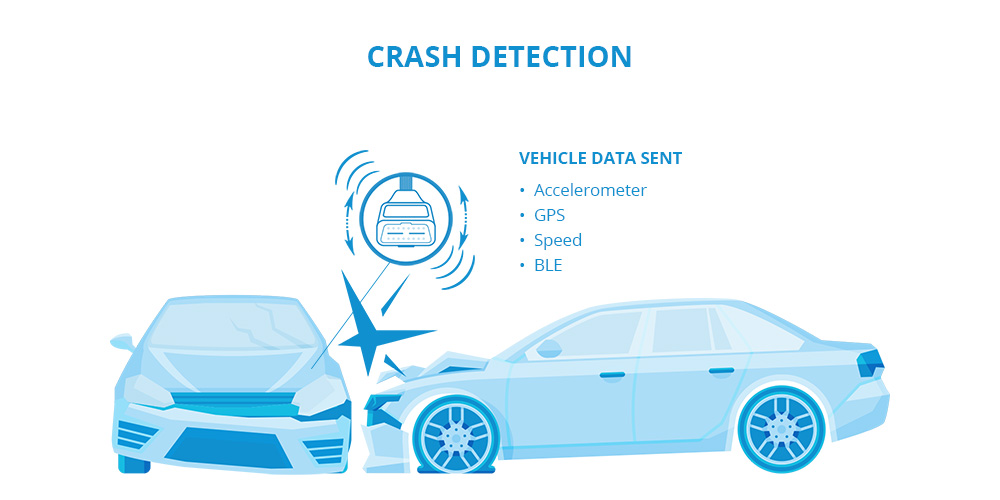
Besides the collision itself, the Morey MCX1M1/MCX101 can collect detailed data from the accelerometer, GNSS module, and optional Bluetooth sensors. This information is gathered before, during, and after the accident, and is immediately sent to the server using an optimized data exchange protocol.
Custom events
This Morey OBD device provides tailored events based on the wide range of parameters listed below. If any of these values fluctuate or fall into a particular range, an associated event notification will be sent to the server right away.
- Ignition (on/off selected ignition)
- Battery Voltage (internal battery voltage)
- Ignition On Counter (hour meter)
- Movement (start of movement, in sec)
- Battery Current (current consumption internal battery)
- BLE Battery (battery charge of the BLE sensor)
- Data Mode (TCP/UDP)
- Active GSM Operator (operator code)
- BLE Humidity (humidity control)
- GSM Signal (%, GSM level)
- Trip Odometer (current trip mileage)
- BLE RFID (driver identification)
- Sleep Mode (changing sleep mode)
- Total Odometer (total mileage after installing the device)
- BT Status
- GNSS Status (number of satellites)
- Digital Input 1 (voltage on pin #1)
- BLE Fuel Level (fuel control)
- GNSS PDOP/HDOP (GNSS horizontal/vertical accuracy)
- Fuel Used GPS (total consumption)
- BLE Luminosity (cargo opening control)
- External Voltage (on-board network)
- Fuel Rate GPS (consumption per 100 km)
- BLE Custom (custom sensor)
- Speed (GPS speed)
- Instant movement (instant movement)
- BLE Fuel Frequency (fuel control)
- UMTS/LTE Cell ID (Tower ID)
- Battery Level % (discharge of the internal battery)
- BLE Button (SOS button)
- GSM Area Code (LAC of the tower)
- Network Type (network type 3G / LTE, etc.)
- BLE Temperature (temperature control)
- Axis X, Y, Z (acceleration along three axes)
- User ID (tag/driver ID Blue Slim ID)
- ICCID (SIM change)
- Eco Score (driver rating)
Basic events
Several basic events, including but limited to, speeding, jamming, and idling, are not listed here since they are either standard for similar GPS trackers or not relevant for OBD devices.
It’s worth mentioning that the Morey MCX does not have anti-tampering features, such as a casing opening alert. To address that issue, fleet managers should consider sealing the device.
Communicating events to drivers
The Morey MCX1M1 does not have a speaker or buzzer, so it’s not possible to directly inform the driver of any triggered events from the device itself. However, for training purposes, the driver may be notified in alternative ways:
- Navixy app that comes as a component of our fleet management software, which allows drivers and fleet managers to monitor vehicle location and parameters, both current and historical, and be notified about important events.
- Morey driver app that communicates with the device via Bluetooth and allows drivers to receive Push notifications.
Fuel Saving Features
GPS/OBD odometer and fuel readings aren’t the only ways to calculate MPG for fuel savings. The Morey MCX series has other unique features to measure fuel consumption more efficiently and encourage more economical driving habits.
GNSS Fuel Counter
The Morey MCX1M1 can use GNSS to calculate fuel usage based on the distance traveled and display the consumption rate in various speed modes.
The parameters of the fuel consumption meter are set according to the consumption rates of a particular vehicle, as stated in its technical documentation. In this case, you can specify values for three driving modes determined by speed ranges (default values are empty but can be changed):
- City – 18 mph (about 30 km/h)
- Medium – 38 mph (about 60 km/h)
- Highway – 56 mph (about 90 km/h)
For more accurate fuel consumption calculations, the values of additional empirical parameters are required, which can be fully justified for fleets with the same type of vehicles.
When using highway driving mode, add 20% to the base consumption for every 50 km/h (31 mph) above the specified limit. However, these thresholds and allowances can be overridden. In winter, when fuel consumption increases by 7-10%, you can use a correction factor. It will be applied to the calculated value before it is passed to the server.
Idling Fuel Consumption (L/h) is used to calculate fuel consumption when the ignition is on but the vehicle is stationary. The default flow rate is 1 L/h, with a minimum and maximum value of 0 and 5 L/h, respectively. This figure is less than 1.0 L/h for almost all diesel vehicles and is approximately 1.5 – 2.0 L/h for gas vehicles.
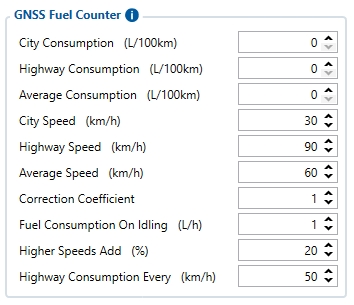
Eco/Green Driving
Since aggressive driving leads to increased fuel consumption, vehicle wear, accidents, and fines, the total cost of owning a vehicle often depends on how safely it’s handled.
The Eco Driving function allows you to reliably determine how carefully employees are driving. The Morey MCX device analyzes six parameters and evaluates each trip on a scale from 0 to 10 points.
Main parameters:
- Sharp acceleration
- Hard braking
- Sharp turning
Additional parameters (taken into account optionally):
- Exceeding the set speed limit
- Extended downtime with the engine running
- Excessively high engine speed (if this parameter is read via OBDII)
The rating value ranges from 0.00 (very bad) to 10.00 (excellent):
| Very bad (0.00 – 1.99) | Bad (2.00 – 3.99) | Medium (4.00 – 5.99) | Good (6.00 – 7.99) | Excellent (8.00 – 10.00) |
Accordingly, the ECOscore is determined by the formula:
ECOscore = (10 / Egen) × (D × Eallowed / 100)
Where:
E allowed = The number of allowed events of this type per 100 km of tracking
D = Distance traveled in km
E gen = Total generated events
After installation, the accelerometer is calibrated once to ensure the Eco Driving function operates properly. The automatic calibration process is as follows:
- Stop the car on a flat, straight road without a slope
- Send SMS command “auto_calibrate:set”
- Accelerate within 5 seconds to a speed of at least 18 mph (30 km/h)
Successful completion of the calibration is confirmed by an SMS message.
OBD Reading Capabilities
Morey GPS trackers are the clear way to go if you’re looking for comprehensive OBDII readings. They have capabilities for obtaining OBDII data as defined by the SAE J1979 standard. Along with supporting standard pinout readings, these devices can also read OEM parameters. This extra information is gathered from both conventional and electric vehicles, and delivers unique benefits that are not available from many competitors. This makes the MCX a good choice for applications that depend on extensive vehicle telemetry, including leasing and car-sharing fleets, insurance telematics, and corporate vehicles.
Starting with firmware version 03.27.12.Rev.143 released in May 2022, the Morey MCX1M1 now features full OBD II data PIDs. The company continuously pays attention to OBDII data readings by adding new manufacturer-defined parameters and sharing detailed information with customers about what data can be acquired from specific vehicles.
Common OBD parameters
The table below outlines the extensive list of common OBD parameters that Morey devices are capable of reading. This comprehensive selection allows you to keep track of and monitor every element of your vehicle’s performance with ease.
| Property Name | Description | Units |
|---|---|---|
| VIN | VIN number | – |
| Number of DTC | Number of DTC (number of errors) | – |
| Engine Load | Calculated engine load value | % |
| Coolant Temperature | Engine coolant temperature | °C |
| Short Fuel Trim | Short term fuel trim 1 | % |
| Fuel pressure | Fuel pressure | kPa |
| Intake MAP | Intake manifold absolute pressure | kPa |
| Engine RPM | Engine RPM | rpm |
| Vehicle Speed | Vehicle Speed | km/h |
| Timing Advance | Timing advance | ° |
| Intake Air Temperature | Intake Air Temperature | °C |
| MAF | MAF air flow rate | g/sec |
| Throttle Position | Throttle Position | % |
| Runtime since engine start | Runtime since engine start | s |
| Distance Traveled MIL On | Distance traveled MIL on | km |
| Relative Fuel Rail Pressure | Relative Fuel Rail Pressure | kPa |
| Direct Fuel Rail Pressure | Direct Fuel Rail Pressure | kPa |
| Commanded EGR | Commanded EGR | % |
| EGR Error | EGR Error | % |
| Fuel Level | Fuel Level | % |
| Distance Since Codes Clear | Distance Since Codes Clear | km |
| Barometric Pressure | Barometric Pressure | kPa |
| Control Module Voltage | Control Module Voltage | V |
| Absolute Load Value | Absolute Load Value | % |
| Fuel Type | Fuel Type | – |
| Ambient Air Temperature | Ambient Air Temperature | °C |
| Time Run With MIL On | Time Run With MIL On | min |
| Time Since Codes Cleared | Time Since Codes Cleared | min |
| Absolute Fuel Rail Pressure | Absolute Fuel Rail Pressure | kPa |
| Hybrid battery pack life | Hybrid battery pack remaining life | % |
| Engine Oil Temperature | Engine Oil Temperature | °C |
| Fuel injection timing | Fuel injection timing | ° |
| Hybrid System Voltage | Hybrid vehicle system voltage | V |
| Hybrid System Current | Hybrid vehicle system current | A |
| Fault Codes | Fault Codes (values separated via “,”) (error numbers) | – |
| Fuel Rate | Engine fuel rate, L/h*100 | L/h |
OEM/OBD parameters
While car manufacturers tend to restrict access to OBD data readings, the engineers at Morey have worked relentlessly to expand the list of models from which fuel and mileage information can be read. The company maintains the list of cars supported and tested, as well as which parameters are supported.
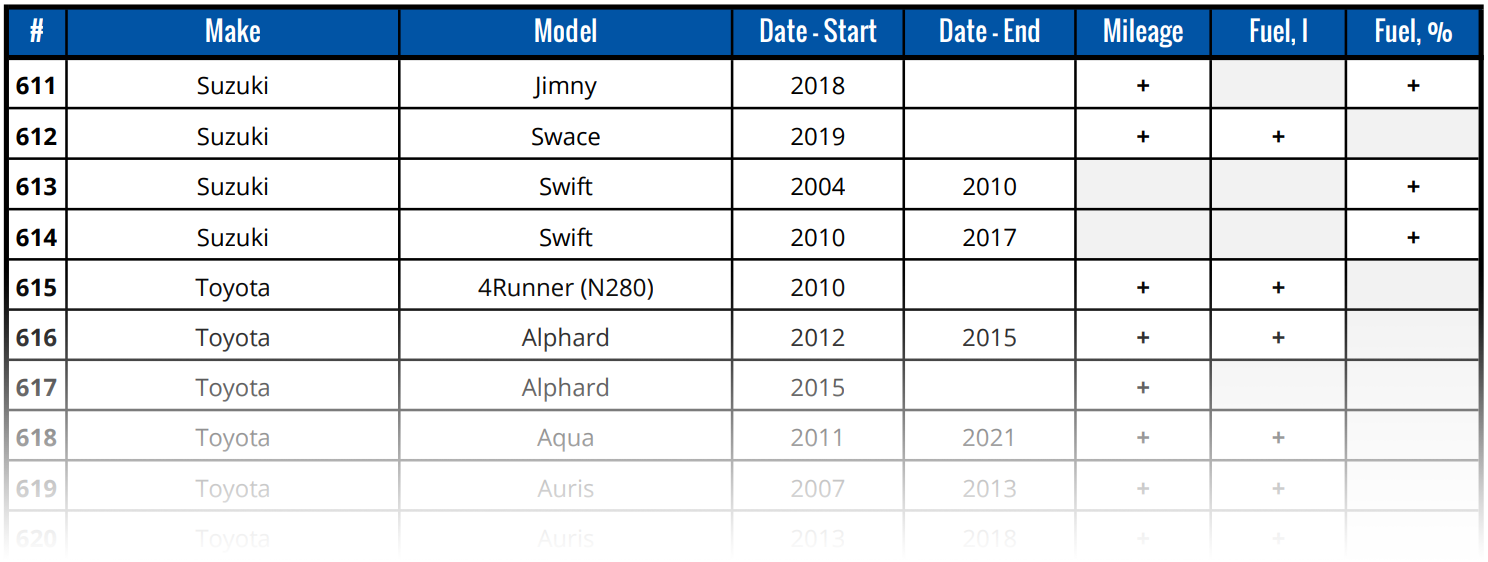
Thanks to the support of OEM/OBD parameters, it’s also possible to use the Morey GPS device in electric vehicles. Available parameters for EV and Hybrid vehicles include:
| Property Name | Description | Units |
|---|---|---|
| OBD OEM Total Mileage | Total mileage received by requesting vehicle specific PID | km |
| OBD OEM Fuel Level | Fuel level in liters received by requesting vehicle specific PID | L |
| OEM Battery charge state | 0 – Not charging1 – Charging | 0/1 |
| OEM Battery charge level | Represents battery charged level | % |
| OEM Battery power consumption | Represents battery power consumption | kWh/100km |
| OEM Remaining distance | Remaining distance until fuel tank empty or battery (EV) is depleted | km |
The list of tested EV/Hybrid makes and models is constantly growing and includes Tesla, Audi, BMW, Hyundai, Kia, Smart, and others. It also provides details about what data is potentially available in similar cars.
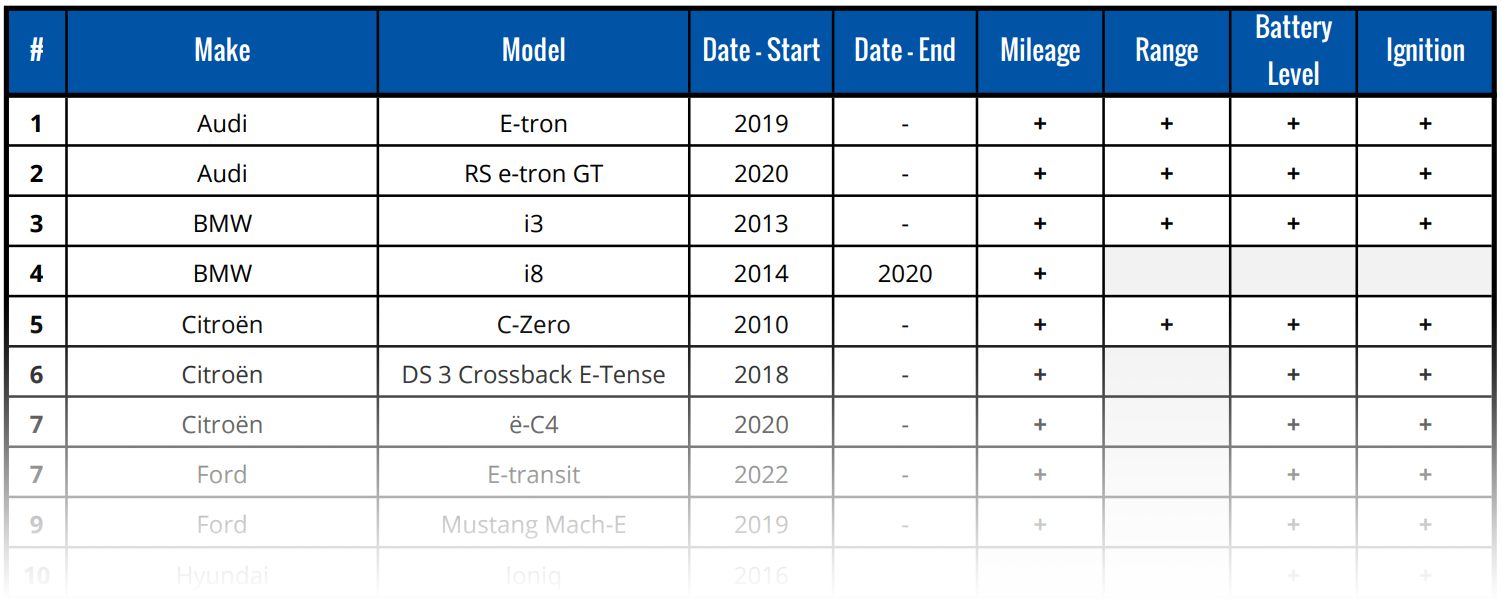
Bluetooth Connectivity
The Morey MCX1M1 is equipped with Bluetooth LE 4.0, which may be used for connecting external equipment, such as sensors, and for configuring the device from a PC or via the mobile app.
- Connecting external equipment: BLE connectivity is not unique to Morey OBD trackers; a number of competitors also offer this feature. However, Morey’s implementation of Bluetooth is particularly commendable for its wide assortment of supported sensors and other equipment:
- Wireless interlock relay (interrupting ignition or fuel pump)
- Wireless panic button
- Measuring sensors for fuel (for example, Escort TD-BLE), temperature and humidity, magnetic field (EYE Beacon / EYE Sensor or Escort TH-BLE)
- Magnetic field sensor and light sensor (to detect the opening of a container or cargo)
- Driver ID (Blue Slim ID)
- Tire pressure sensor (only supported by Continental TPMS)
Up to four Bluetooth devices can be connected to the OBD tracker simultaneously.
- Device configuration: The device can be configured from a PC via Windows software or USB cable. Additionally, there is a mobile app that allows for limited configuration of basic settings such as APN and server connection.
Configuration: Local and OTA
The device can be configured both locally and remotely. The firmware is password protected to prevent settings from being changed by an unauthorized person.
| Local configuration | |
|---|---|
| USB connection | A standard USB / micro USB cable is used for connecting the device to a PC. There is a Windows-based configuration tool provided by the manufacturer. |
| Bluetooth connection | A device may be configured from a PC in the same manner as when using a USB cable. Additionally, there is an Android mobile app that allows limited configuration of basic parameters including APN and server connection. |
| Remote configuration | |
|---|---|
| SMS commands | SMS commands enable remotely changing the complete range of the device settings. Once the command is executed, the sender receives an SMS response.One particular issue with SMS commands is that their syntax requires that the device login and password come at the beginning of every command, delimited with spaces. If these are not set (particularly when the device is brand new), it results in two leading spaces in the text message. Unfortunately, many SMS gateway services, including popular choices like Twilio and Nexmo, remove these spaces at the beginning as insignificant, and the command fails to execute. |
| IP commands | Once the connection to the server is established, the device can execute binary IP commands with a response to the server. The majority of device parameters can be set remotely, including firmware updates, meaning that OTA configuration has practically no restrictions. |
Remote management for Morey devices is fully supported in Navixy and implemented through both SMS and IP channels. For higher cost efficiency, Navixy generally relies on IP communication for automatic activation, setting changes by users, and configuration/diagnostic tools for technicians and support teams.
As a workaround for the double-leading spaces in the SMS channel, Navixy offers dedicated paths for IoT commands sent to Morey devices.
The Bottom Line
Based on our findings, Navixy can confidently state that the Morey MCX series is an exceptional OBD tracking device, thanks to its advanced technologies, significant configuration flexibility, and affordability.
With a multi-GNSS module that’s bolstered by Assisted GPS and Cell-ID capabilities, this tracker is designed to offer highly accurate and reliable location data in all environments. Furthermore, these features can be customized in all ways to suit specific tracking requirements.
Extensive OBDII readings (full PIDs including OEM) make the Morey MCX a good choice for conventional cars, hybrid and electric models, vans, and light trucks of various makes. However, despite being suitable for 24V board power, this device does not support J1939 readings from heavy-duty vehicles.
The MCX tracker is continuously backed by its manufacturer and will continue to receive frequent software updates Over-the-Air, granting even more features in the future. One of the benefits of using a tracker from a reputable vendor is unparalleled reliability, since they have a very small chance of any disruptive reboots, resets, or halts.
For fast connectivity, the MCX series has you covered with both LTE Cat M1 and Cat 1 compatibility, so you can confidently use your device in the US, Canada, Mexico, and anywhere else with reliable 4G.
Does the Morey MCX series sound like the right OBD tracker for your next project? If so, the experts at Navixy are ready to assist! We’ll gladly tell you more about how our platform complements its features and how you can use it for a multitude of IoT applications. Our team looks forward to speaking with you soon.
